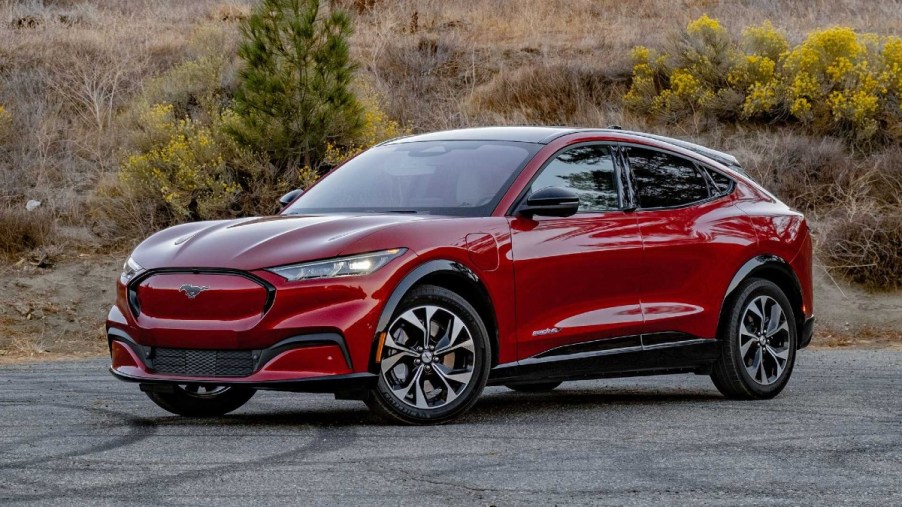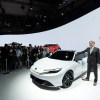
Ford Model E and Blue Divisions Split the Company in Two
We’d heard rumors of Ford branching off into a second company for its electric vehicles. Although it isn’t exactly the same, the source of the rumors is likely what’s just happened. Ford split into two divisions, Model E for EVs and Blue for gas options. They’ll continue to share resources and innovations but operate as two separate businesses. Here’s how the Ford Model E and Blue divisions split the company in two.
Ford Model E divison: A focus on electric vehicles and innovations

According to Ford, the Model E division will have all the access to the automaker’s high-volume manufacturing ability, plus the “speed of a startup at the leading edge of technology.” Part of that is developing new products and innovations for the EV industry—specifically things like EV platforms, batteries, electric motors, inverters, charging, and other systems. Moreover, the group working for the Model E division is responsible for developing the software platforms and user experience for all Ford vehicles, regardless of division. In addition, the team will create a new way to shop for a car. Ford’s announcement called it “simple, intuitive e-commerce platforms, transparent pricing, and personalized customer support.”
Meanwhile, the Blue Oval said it will produce 2 million EVs per year by 2026. Other recent reports had the automaker slated to produce 600,000 EVs each year by 2023. Although it’s a three-year difference, that’s a shockingly significant jump in production. However, with Ford’s investment and the two hyper-focused divisions, who knows what it can accomplish? Ford is investing $5 billion in EVs in 2022 and plans for half its global volume to be EVs by 2030.
Ford Blue divison: Continue carrying the gas-powered torch

Electric vehicles are great, but people still want their Ford F-150 pickup truck and Bronco SUV. Some people will never want to switch to an EV, no matter how great automakers make them. Ford’s Blue division is responsible for these gas-powered vehicles. Ford won’t shy away from investing in these vehicles, but according to CEO Jim Farley, it will only be in specific segments like trucks.
“Ford Blue is going to be the profit engine of Ford delivering the lifeblood to fund our future,” Stuart Rowley, Chief Transformation and Quality Officer, said, according to Motor1. Therefore, the American automaker is using the Blue division’s profitability to continue to fund EV development for the time being.
Why is Ford splitting into two divisons?
According to Automotive News, Ford is separating the two parts of the business to boost profits. Ford told AN that it is “separating its internal combustion and electric vehicle businesses with a goal of increasing profit margins and getting engineers, designers, and developers more focused on the unique needs of each powertrain.”
The automaker expects EVs to be 30 percent of its sales within five years and half by 2030. Ford aims to achieve a 10 percent total company-adjusted pre-tax earnings margin with the new split structure by 2026. Most importantly, that’s almost double the amount posted in 2021 by the single-division automaker.
In speaking with Automotive News, CEO Jim Farley said, “our legacy organization has been holding us back. We had to change.” Those are powerful words from the company leader, but understandably so. Difficulties lie ahead for Ford to move forward as an EV brand competing against Tesla and Rivian. The American brand is known for trucks, Broncos, and Mustangs, and that’s what their fans and customers expect of them. Consequently, separating customers interested in those classic vehicles from the new ones needing an excellent electric model is an easy way to solve that problem.
Will every Ford dealer sell Model E and Blue division models?
Ford is planning changes for its dealerships and the way they operate. Moreover, a certain number of dealers will need to opt-in to selling EVs under a new set of standards from the automaker. Criteria will include carrying no inventory, selling at nonnegotiable prices, and being held to fewer facility requirements. According to AN, Farley declined to answer how many dealers he wants to opt-in to selling EVs. In short, it seems that every dealer will have gas-powered vehicles, but not all of them will carry electric models.
In conclusion, the split into two divisions is massive news for Ford Motor Company. Will other classic automotive brands start doing the same thing? Automakers like Chevrolet and Toyota suffer from the same “legacy” issue Jim Farley noted. As the market shifts into electric vehicles, it’s difficult for these well-established powerhouses to convert their fan base or acquire an entirely new one. That’s how Ford Model E and Blue divisions split the company in two.



